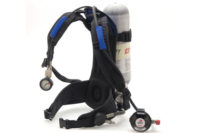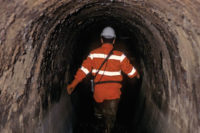
Self-contained breathing apparatus
Identifying the proper personal protective equipment (PPE), specifically respiratory protection, for either day-to-day operations or emergency response jobs is often challenging.
Whether it is a confined space, emergency response or maintenance operations, proper respiratory protection will not only provide worker safety, but keeps him or her comfortable in often stressful situations. Respiratory hazards vary among industries, but consist primarily of particulates and gases. These hazards can be continually present, requiring respiratory protection at all times, or present only in emergency situations such as gas leaks or fire.
Regardless of the hazard, the foundation for choosing any respiratory PPE is identifying the specific or potential hazards of the environment in which an employee will be working. The first step in this process is proper and thorough air quality monitoring to determine the level of respiratory protection needed to keep the worker safe. This is done through fixed or portable gas detectors, which are used to determine concentrations of contaminants in a workspace.

Fixed gas detectors
Fixed gas detection
Fixed gas detection is a continuous monitoring system that detects potential hazards throughout a facility. Sensor points detect any potential gas, either toxic or combustible, or the presence of flame. Because some processes are not monitored by a worker, they require constant monitoring for potential hazards due to their volatile nature. In the event of a toxic gas leak, the fixed system will be tied into a control panel that will set off an alarm, in the area of the leak or facility-wide, notifying workers to evacuate. The control panel will activate the facility’s ventilation system and shut down processes to limit concentration levels. For the first responder and maintenance crews, the fixed detector can provide real-time toxic gas levels so they can determine what level of respiratory protection is needed to respond.Portable gas detection
Portable gas detection, available in single and multiple gas detection models, are used for personal gas monitoring before entering or while working in a hazardous area. Many work environments require daily use of personal gas detectors, such as carbon monoxide in steel manufacturing and hydrogen sulfide in the petroleum industry. In confined space applications, monitoring of O2, combustible gases as well as specific toxic gases, requires constant personal monitoring. All portable gas detection is used to let the user know when the environment is safe to work with or without respiratory protection, or when a higher level of respiratory protection is needed. When a personal gas detector alarms, it is suggested workers evacuate to a safe environment and not re-enter that workspace until the proper form of respiratory protection is provided.
Four-hour closed-circuit breathing apparatus
Choosing PPE
The concentration of the respiratory hazard in the workspace, and the duration workers will be in the area, will determine the proper respiratory protection required.Environments where the worker is only required to escape the area in an event of an alarm, the worker needs to be equipped with an Emergency Escape Breathing Device (EEBD). EEBDs are often mounted to a wall or carried with a worker to be used in the event there is an alarm situation, upon which the worker would don the respirator and egress to a safe environment.
If there is a specific task that needs to be completed in an Immediately Dangerous to Life and Health (IDLH) environment, the worker must be provided an entry and exit Supplied-Air Respirator (SAR) or a Self-Contained Breathing Apparatus (SCBA). The SAR consists of an airline supplying the worker with the primary source of grade D breathing air from a remote location outside the workspace. Additionally, the SAR has a compressed air cylinder worn on the hip or back used for egress in the event the primary airline air source is lost.
An SCBA eliminates the need for an airline tether to the primary air source allowing the worker to carry the full supply (30 to 60 minutes) of grade D breathing air with them into the hazardous environment. This provides the worker freedom to move without dragging an airline, but limits the work time to less than 60 minutes. A long-duration SCBA, called a Closed-Circuit Breathing Apparatus (CCBA), can provide 240 minutes or 4 hours of work time and is ideal for any long duration tasks that could be potentially IDLH, except the presence of fire.
If it is determined that the hazardous environment is below the IDLH levels, the user can choose an Air-Purifying Respirator (APR) or Powered Air-Purifying Respirator (PAPR). OSHA 1910.134 states, “The employer must select a respirator for employee use that maintains the employee’s exposure to the hazardous substance, when measured outside the respirator, at or below the Maximum Use Concentration (MUC).” The MUC is calculated by multiplying the assigned protection factor (APF) by the OSHA Permissible Exposure Limit (PEL), Short-term Exposure Limit (STEL) or ceiling limit.
Be sure to always choose a respirator that is, at minimum, approved by NIOSH. Always reference the OSHA 1910.134 Respiratory Protection Standard when choosing a respirator and issuing respirators for a specific job. When working to identify proper PPE, including respiratory protection, reference the NIOSH Pocket Guide to Chemical Hazards for exposure limits, respirator recommendations and other specific information associated with industrial hazards.




